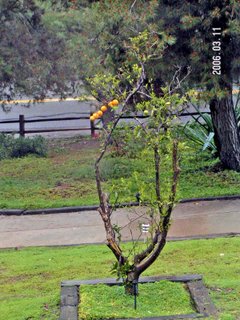At one end of the continuum, is the mature Zen garden, patiently steeped in a mysterious silence, its solid rocks surrounded by ripples of raked sand, evoking a vast, timeless and enduring landscape. At the other end is the cookie-cutter suburban front yard, where a self-consciously random, gently undulating wave of trendy plants is crowded uncomfortably between the private residence and the public street. Add a “water feature” to provide that faux zen feel, and Bao Yu's your uncle.
 A more candid glimpse of a garden's lifestyle is the humble backyard garden. Back yards are generally planted and cultivated for the pleasure of the grower, rather than for the mass market curb appeal that lowest common denominator appeal of front yard landscaping, or the hurried, three-day-weekend attempt to recreate the contemplative peace of a hundred-year old bonsai. Sometimes back yard gardens will include herbs and vegetables; sometimes flowers; often spontaneous combinations of both.
A more candid glimpse of a garden's lifestyle is the humble backyard garden. Back yards are generally planted and cultivated for the pleasure of the grower, rather than for the mass market curb appeal that lowest common denominator appeal of front yard landscaping, or the hurried, three-day-weekend attempt to recreate the contemplative peace of a hundred-year old bonsai. Sometimes back yard gardens will include herbs and vegetables; sometimes flowers; often spontaneous combinations of both. The down side of back yard garden lifestyles is that such efforts are often notable for their resounding disconnect between vision and execution. There will be a random patch of dead and yellowing plants and barren spots, punctuated by diseased or crippled plants. Often growers try to rescue these failures by adding mass market appeal “garden art” from their local handyman/fertilizer/tool rental store: plastic trellises, unauthentic oriental cast resin lanterns and bridges, or fantastical bird houses. Unsurprisingly, such decorations usually don't successfully blend into the landscape, but can be found cowering in a corner of the patio - like invading paratroopers snagged on French country church steeples.
But the good thing about backyard gardens - even imperfectly executed ones - is their mute testimony of the grower's boundless hope, persistent vision, and stubborn love. A living back yard garden is characterized by a dynamic work-in-progress feel. Growing gardens always include evidence of failure. Like haunting pictures of concentration camp survivors as seen by liberating GIs, what remains at the end of the season in these gardens are the plants that survived despite poor planning, harsh weather, neglect, and cruel experiments in living conditions for which they were not designed. As much as I'd love to grow the lilacs, violets and lilies of the valley from my childhood memories, my climate zone will not support them. The plants my mother loved in Zone 3, die slow and painful deaths here in Zone 9, sacrificed on the alter of my ignorance and hubris.
 While the surviving plants might be unrecognizable compared to their picture in the seed catalog, their struggle has given them character. And therein lies the lesson. Gardens, even in their messy failures, show us that life is a veil of frickin' tears, baby. And love and pesticide alone aren't enough to get you through. Embrace the failure of your dreams and visions, and plan for next spring. Celebrate the noble attempt of the doomed lilac, bursting forth with delicate leaves each spring, only to be toasted and battered by the harsh light of a summer day. It's the great cycle of life, and I'm delighted to be part of it.
While the surviving plants might be unrecognizable compared to their picture in the seed catalog, their struggle has given them character. And therein lies the lesson. Gardens, even in their messy failures, show us that life is a veil of frickin' tears, baby. And love and pesticide alone aren't enough to get you through. Embrace the failure of your dreams and visions, and plan for next spring. Celebrate the noble attempt of the doomed lilac, bursting forth with delicate leaves each spring, only to be toasted and battered by the harsh light of a summer day. It's the great cycle of life, and I'm delighted to be part of it.
No comments:
Post a Comment